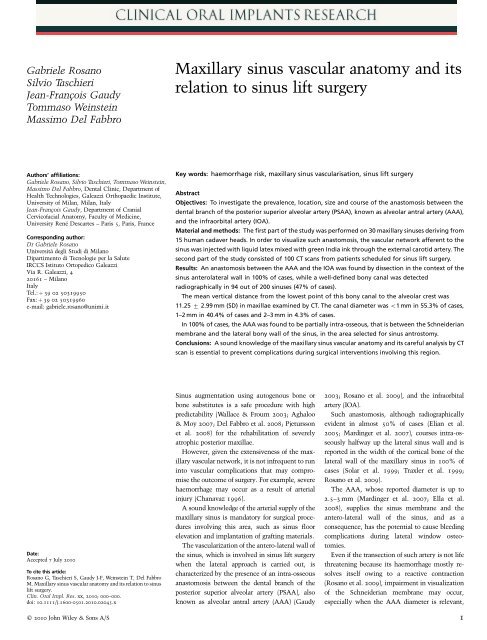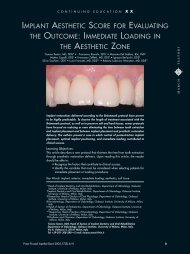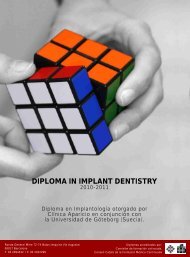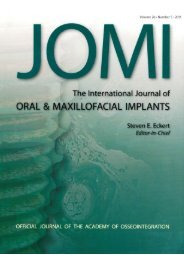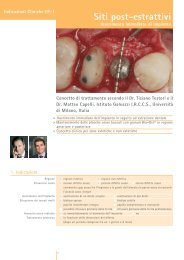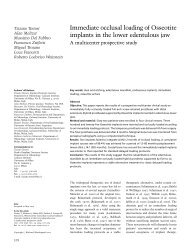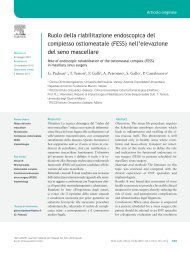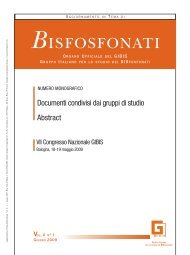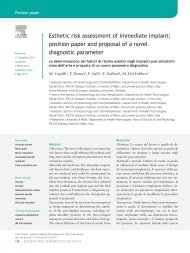Maxillary sinus vascular anatomy and its relation to sinus lift surgery
Maxillary sinus vascular anatomy and its relation to sinus lift surgery
Maxillary sinus vascular anatomy and its relation to sinus lift surgery
You also want an ePaper? Increase the reach of your titles
YUMPU automatically turns print PDFs into web optimized ePapers that Google loves.
Gabriele Rosano<br />
Silvio Taschieri<br />
Jean-François Gaudy<br />
Tommaso Weinstein<br />
Massimo Del Fabbro<br />
<strong>Maxillary</strong> <strong>sinus</strong> <strong>vascular</strong> <strong>ana<strong>to</strong>my</strong> <strong>and</strong> <strong>its</strong><br />
<strong>relation</strong> <strong>to</strong> <strong>sinus</strong> <strong>lift</strong> <strong>surgery</strong><br />
Authors’ affiliations:<br />
Gabriele Rosano, Silvio Taschieri, Tommaso Weinstein,<br />
Massimo Del Fabbro, Dental Clinic, Department of<br />
Health Technologies, Galeazzi Orthopaedic Institute,<br />
University of Milan, Milan, Italy<br />
Jean-François Gaudy, Department of Cranial<br />
Cervicofacial Ana<strong>to</strong>my, Faculty of Medicine,<br />
University René Descartes–Paris5,Paris,France<br />
Corresponding author:<br />
Dr Gabriele Rosano<br />
Università degli Studi di Milano<br />
Dipartimen<strong>to</strong> di Tecnologie per la Salute<br />
IRCCS Istitu<strong>to</strong> Or<strong>to</strong>pedico Galeazzi<br />
Via R. Galeazzi, 4<br />
20161 – Milano<br />
Italy<br />
Tel.: þ 39 02 50319950<br />
Fax: þ 39 02 50319960<br />
e-mail: gabriele.rosano@unimi.it<br />
Key words: haemorrhage risk, maxillary <strong>sinus</strong> <strong>vascular</strong>isation, <strong>sinus</strong> <strong>lift</strong> <strong>surgery</strong><br />
Abstract<br />
Objectives: To investigate the prevalence, location, size <strong>and</strong> course of the anas<strong>to</strong>mosis between the<br />
dental branch of the posterior superior alveolar artery (PSAA), known as alveolar antral artery (AAA),<br />
<strong>and</strong> the infraorbital artery (IOA).<br />
Material <strong>and</strong> methods: The first part of the study was performed on 30 maxillary <strong>sinus</strong>es deriving from<br />
15 human cadaver heads. In order <strong>to</strong> visualize such anas<strong>to</strong>mosis, the <strong>vascular</strong> network afferent <strong>to</strong> the<br />
<strong>sinus</strong> was injected with liquid latex mixed with green India ink through the external carotid artery. The<br />
second part of the study consisted of 100 CT scans from patients scheduled for <strong>sinus</strong> <strong>lift</strong> <strong>surgery</strong>.<br />
Results: An anas<strong>to</strong>mosis between the AAA <strong>and</strong> the IOA was found by dissection in the context of the<br />
<strong>sinus</strong> anterolateral wall in 100% of cases, while a well-defined bony canal was detected<br />
radiographically in 94 out of 200 <strong>sinus</strong>es (47% of cases).<br />
The mean vertical distance from the lowest point of this bony canal <strong>to</strong> the alveolar crest was<br />
11.25 2.99 mm (SD) in maxillae examined by CT. The canal diameter was o1 mm in 55.3% of cases,<br />
1–2 mm in 40.4% of cases <strong>and</strong> 2–3 mm in 4.3% of cases.<br />
In 100% of cases, the AAA was found <strong>to</strong> be partially intra-osseous, that is between the Schneiderian<br />
membrane <strong>and</strong> the lateral bony wall of the <strong>sinus</strong>, in the area selected for <strong>sinus</strong> antros<strong>to</strong>my.<br />
Conclusions: A sound knowledge of the maxillary <strong>sinus</strong> <strong>vascular</strong> <strong>ana<strong>to</strong>my</strong> <strong>and</strong> <strong>its</strong> careful analysis by CT<br />
scan is essential <strong>to</strong> prevent complications during surgical interventions involving this region.<br />
Date:<br />
Accepted 7 July 2010<br />
To cite this article:<br />
Rosano G, Taschieri S, Gaudy J-F, Weinstein T, Del Fabbro<br />
M. <strong>Maxillary</strong> <strong>sinus</strong> <strong>vascular</strong> <strong>ana<strong>to</strong>my</strong> <strong>and</strong> <strong>its</strong> <strong>relation</strong> <strong>to</strong> <strong>sinus</strong><br />
<strong>lift</strong> <strong>surgery</strong>.<br />
Clin. Oral Impl. Res. xx, 2010; 000–000.<br />
doi: 10.1111/j.1600-0501.2010.02045.x<br />
Sinus augmentation using au<strong>to</strong>genous bone or<br />
bone substitutes is a safe procedure with high<br />
predictability (Wallace & Froum 2003; Aghaloo<br />
& Moy 2007; Del Fabbro et al. 2008; Pjetursson<br />
et al. 2008) for the rehabilitation of severely<br />
atrophic posterior maxillae.<br />
However, given the extensiveness of the maxillary<br />
<strong>vascular</strong> network, it is not infrequent <strong>to</strong> run<br />
in<strong>to</strong> <strong>vascular</strong> complications that may compromise<br />
the outcome of <strong>surgery</strong>. For example, severe<br />
haemorrhage may occur as a result of arterial<br />
injury (Chanavaz 1996).<br />
A sound knowledge of the arterial supply of the<br />
maxillary <strong>sinus</strong> is m<strong>and</strong>a<strong>to</strong>ry for surgical procedures<br />
involving this area, such as <strong>sinus</strong> floor<br />
elevation <strong>and</strong> implantation of grafting materials.<br />
The <strong>vascular</strong>ization of the antero-lateral wall of<br />
the <strong>sinus</strong>, which is involved in <strong>sinus</strong> <strong>lift</strong> <strong>surgery</strong><br />
when the lateral approach is carried out, is<br />
characterized by the presence of an intra-osseous<br />
anas<strong>to</strong>mosis between the dental branch of the<br />
posterior superior alveolar artery (PSAA), also<br />
known as alveolar antral artery (AAA) (Gaudy<br />
2003; Rosano et al. 2009), <strong>and</strong> the infraorbital<br />
artery (IOA).<br />
Such anas<strong>to</strong>mosis, although radiographically<br />
evident in almost 50% of cases (Elian et al.<br />
2005; Mardinger et al. 2007), courses intra-osseously<br />
halfway up the lateral <strong>sinus</strong> wall <strong>and</strong> is<br />
reported in the width of the cortical bone of the<br />
lateral wall of the maxillary <strong>sinus</strong> in 100% of<br />
cases (Solar et al. 1999; Traxler et al. 1999;<br />
Rosano et al. 2009).<br />
The AAA, whose reported diameter is up <strong>to</strong><br />
2.5–3 mm (Mardinger et al. 2007; Ella et al.<br />
2008), supplies the <strong>sinus</strong> membrane <strong>and</strong> the<br />
antero-lateral wall of the <strong>sinus</strong>, <strong>and</strong> as a<br />
consequence, has the potential <strong>to</strong> cause bleeding<br />
complications during lateral window osteo<strong>to</strong>mies.<br />
Even if the transection of such artery is not life<br />
threatening because <strong>its</strong> haemorrhage mostly resolves<br />
<strong>its</strong>elf owing <strong>to</strong> a reactive contraction<br />
(Rosano et al. 2009), impairment in visualization<br />
of the Schneiderian membrane may occur,<br />
especially when the AAA diameter is relevant,<br />
c 2010 John Wiley & Sons A/S 1
Rosano et al Haemorrhage risk during <strong>sinus</strong> <strong>surgery</strong><br />
making <strong>its</strong> elevation far more difficult <strong>and</strong> interfering<br />
with placement of the graft material.<br />
In such a context, the purpose of this cadaveric<br />
<strong>and</strong> CT scan study was <strong>to</strong> investigate the prevalence,<br />
location, size <strong>and</strong> course of the AAA<br />
located on the anterior lateral wall of the maxillary<br />
<strong>sinus</strong>, so as <strong>to</strong> provide indications for<br />
improving the safety of <strong>sinus</strong> floor elevation<br />
procedure, especially in cases of extreme atrophy<br />
of the alveolar process.<br />
Material <strong>and</strong> methods<br />
Fig. 1. View of the anterolateral wall of the maxillary <strong>sinus</strong> by transillumination: the alveolar antral artery dissection is carried<br />
out in the area selected for <strong>sinus</strong> antros<strong>to</strong>my as far as the infraorbital artery (a) <strong>and</strong> the posterior superior alveolar artery (b) are<br />
visible respectively at <strong>its</strong> medial <strong>and</strong> distal extremity. The bony vessel is strictly stick <strong>to</strong> the Schneiderian membrane.<br />
Fig. 2. Computed <strong>to</strong>mography scan 3D view of the lateral wall of the maxillary <strong>sinus</strong> which shows the point of emergence of<br />
the infraorbital artery (IOA) (1), the point of anas<strong>to</strong>mosis between the IOA <strong>and</strong> the alveolar antral artery (AAA) (2) as well as<br />
the route of the AAA (3) forming a small concavity (white arrow).<br />
Thefirstpar<strong>to</strong>fthestudywasperformedon30<br />
maxillary <strong>sinus</strong>es, deriving from 15 human<br />
cadaver heads. The specimens belonged <strong>to</strong> subjects<br />
with an age range of 59–90 years (mean age<br />
76 years) <strong>and</strong> equal sex distribution, who had<br />
donated their body for research purpose. The<br />
study obtained ethical approval from the Department<br />
of Ana<strong>to</strong>my at the Faculty of Medicine<br />
René Descartes of Paris 5 (Paris 5 University,<br />
Paris). Direct visualization of the AAA was<br />
obtained by fenestrating the anterior lateral<br />
wall of the <strong>sinus</strong> cavity <strong>and</strong> <strong>its</strong> dissection was<br />
carried out as far as the IOA <strong>and</strong> the PSAA were<br />
visible at <strong>its</strong> extremities (Fig. 1), in order <strong>to</strong><br />
determine <strong>its</strong> course with respect <strong>to</strong> both the<br />
Schneiderian membrane <strong>and</strong> the buccal antral<br />
wall.<br />
To detect such an artery, the <strong>vascular</strong> network<br />
afferent <strong>to</strong> the <strong>sinus</strong> was injected with liquid latex<br />
mixed with green India ink through the external<br />
carotid artery.<br />
The second part of the study consisted of 100<br />
CT scans from 100 patients scheduled for <strong>sinus</strong><br />
<strong>lift</strong> <strong>surgery</strong> at the Dental Clinic of the IRCCS<br />
Istitu<strong>to</strong> Or<strong>to</strong>pedico Galeazzi, Università degli<br />
Studi di Milano. The age range was 29–78<br />
(mean: 53.5) years.<br />
The CT scans were performed using a 2000<br />
SOMATOM Volume Zoom 4 slice CT scanner<br />
(Siemens AG, Medical Solutions, Forchheim,<br />
Germany) with slices of 0.5 mm thickness. CT<br />
images were investigated for the presence of a<br />
bony canal, housing the AAA, in the context of<br />
the <strong>sinus</strong> anterolateral wall.<br />
Coronal, axial <strong>and</strong> sagittal views of the maxillary<br />
<strong>sinus</strong> were obtained by means of a software<br />
for 3D reconstruction (OneScan 3D, 3D-MED<br />
s.r.l., Brescia, Italy), offering a pho<strong>to</strong>realistic<br />
rendering quality <strong>and</strong> able <strong>to</strong> import Dicom<br />
formatted CT images.<br />
The route of the AAA was assessed with<br />
respect <strong>to</strong> the Schneiderian membrane <strong>and</strong> <strong>to</strong><br />
the bony wall, as well as <strong>its</strong> diameter <strong>and</strong> the<br />
distance from <strong>its</strong> lowest point <strong>to</strong> the alveolar<br />
crest, with a precision of 0.1 mm. The corresponding<br />
ridge height was measured. The cor<strong>relation</strong><br />
between the residual ridge height <strong>and</strong> the<br />
distance between the AAA <strong>and</strong> the crest was also<br />
analysed.<br />
Only edentulous or partially edentulous maxillae<br />
displaying Class V or VI resorption of<br />
the alveolar process, according <strong>to</strong> Cawood &<br />
Howell’s classification (1988), were taken in<strong>to</strong><br />
consideration.<br />
Results<br />
The ana<strong>to</strong>mical dissection confirmed that the<br />
PSAA divides in<strong>to</strong> two branches along <strong>its</strong> course:<br />
an external (gingival) branch is directed <strong>to</strong>wards<br />
the superior buccal fornix <strong>and</strong> the maxillary<br />
tuberosity; the other branch is internal (dental)<br />
<strong>and</strong>, after coursing below the zygomatic process,<br />
was found <strong>to</strong> point <strong>to</strong>wards the inside of the<br />
orbit making a circular anas<strong>to</strong>mosis with the<br />
IOA.<br />
An intra-osseous anas<strong>to</strong>mosis between the<br />
AAA <strong>and</strong> the IOA was found by dissection in<br />
100% of the ana<strong>to</strong>mical cases (30/30 <strong>sinus</strong>es),<br />
while a well-defined bony canal, located in the<br />
context of the <strong>sinus</strong> anterolateral wall, was detected<br />
radiographically in 94 out of 200 <strong>sinus</strong>es<br />
examined (47% of cases).<br />
The diameter of such bony canal was o1mm<br />
in 52 <strong>sinus</strong>es (55.3% of 94 cases), 1–o2mm in<br />
38 <strong>sinus</strong>es (40.4%) <strong>and</strong> 2mminfour<strong>sinus</strong>es<br />
(4.3%).<br />
The AAA displayed three different courses: (1)<br />
within the buccal antral wall cortex; (2) between<br />
the Schneiderian membrane <strong>and</strong> the lateral bony<br />
wall of the <strong>sinus</strong>, in which a small concavity was<br />
often visible (Figs 2 <strong>and</strong> 3); <strong>and</strong> (3) under the<br />
periosteum of the <strong>sinus</strong> lateral wall.<br />
In particular, the AAA course was found <strong>to</strong> be<br />
(1) completely intra-osseous at <strong>its</strong> extremities in<br />
100% of cases (Fig. 4); (2) partially intra-osseous<br />
in the area usually involved with <strong>sinus</strong> antros<strong>to</strong>my<br />
(from second premolar <strong>to</strong> second molar) in<br />
100% of cases (Fig. 4). In such an area, the AAA<br />
was strictly close <strong>to</strong> the Schneiderian membrane<br />
<strong>and</strong> partially encased in the lateral <strong>sinus</strong> wall<br />
in all specimens. No bony layer interposed<br />
between the AAA <strong>and</strong> the <strong>sinus</strong> membrane<br />
could be identified by dissection (Figs 1 <strong>and</strong> 5);<br />
<strong>and</strong> (3) variable (either intra-osseous or intra-<br />
2 | Clin. Oral Impl. Res. 10.1111/j.1600-0501.2010.02045.x c 2010 John Wiley & Sons A/S
Rosano et al Haemorrhage risk during <strong>sinus</strong> <strong>surgery</strong><br />
<strong>sinus</strong>al or sub-periosteal) in the maxillary tuberosity<br />
area.<br />
The vertical distance from the lowest point of<br />
the vessel, corresponding <strong>to</strong> the first molar area,<br />
<strong>to</strong> the alveolar crest averaged 11.25 2.99 (SD)<br />
mm (range between 7.2 <strong>and</strong> 17.7 mm).<br />
The residual ridge height ranged from 0.7 <strong>to</strong><br />
5.1 mm (mean height 3.60 1.28 mm). A slight<br />
positive cor<strong>relation</strong> between such a distance <strong>and</strong><br />
the ridge height was observed (r ¼ 0.38). When<br />
considering a threshold of 3 mm for the residual<br />
ridge height, the AAA-<strong>to</strong>-alveolar crest distance<br />
averaged 9.33 2.41 (n ¼ 39) <strong>and</strong> 12.45 2.71<br />
(n ¼ 55) for cases with ridge height o3mm <strong>and</strong><br />
3 mm, respectively.<br />
Discussion<br />
The anas<strong>to</strong>mosis between PSAA <strong>and</strong> IOA provides<br />
blood supply <strong>to</strong> the <strong>sinus</strong> membrane, <strong>to</strong> the<br />
periosteal tissues, <strong>and</strong> especially, <strong>to</strong> the anterolateral<br />
wall of the <strong>sinus</strong> (Solar et al. 1999; Rosano<br />
et al. 2009).<br />
The scientific literature reports that this vessel<br />
is located at an average distance of 19 mm (Solar<br />
et al. 1999; Traxler et al. 1999), 16.4 mm (Elian<br />
et al. 2005) <strong>and</strong> 16.9 mm (Mardinger et al. 2007)<br />
from the alveolar crest of the posterior maxilla.<br />
Nevertheless, such data can be misleading<br />
because the height of the residual bony ridge,<br />
the maxillary atrophy class <strong>and</strong> the presence of<br />
Fig. 3. Internal view of the maxillary <strong>sinus</strong>: the arrow A shows the alveolar antral artery, the endosseous branch of the<br />
posterior superior alveolar artery (PSAA), partially encased in the lateral <strong>sinus</strong> wall, while the arrow B shows the infraorbital<br />
artery deriving from the maxillary artery <strong>and</strong> forming a <strong>vascular</strong> arcade with the PSAA.<br />
teeth play a relevant role in determining the<br />
location of the vessel.<br />
In the present study, the average distance of the<br />
AAA from the alveolar ridge in atrophic maxillae<br />
of Cawood & Howell class V <strong>and</strong> VI was<br />
11.25 mm. For the most atrophic cases, in which<br />
the ridge height is inferior <strong>to</strong> 3 mm, such a<br />
distance was significantly lower with respect <strong>to</strong><br />
lesser atrophic cases. This would confirm that<br />
the more resorbed the bone crest, the higher the<br />
risk of violation of such a vessel during <strong>sinus</strong><br />
augmentation procedure.<br />
These results are substantially in agreement<br />
with the study by Mardinger et al. (2007), which<br />
found that this vessel was located at a mean<br />
distance of 10.9 mm from the crest in classes<br />
D, E (Lekholm & Zarb 1985) <strong>and</strong> at a distance<br />
greaterthan15mminclassesA,B<strong>and</strong>C.<br />
Differences concerning the mean distance from<br />
the vessel <strong>to</strong> the crest, with the studies by Solar<br />
et al. (1999), Traxler et al. (1999) <strong>and</strong> Elian et al.<br />
(2005) are probably due <strong>to</strong> the more strict inclusion<br />
criteria considered in the present study,<br />
where only highly atrophic ridges have been<br />
examined.<br />
Moreover, because a well-distinguished bony<br />
wall between the intra-osseous maxillary anas<strong>to</strong>mosis<br />
<strong>and</strong> the maxillary <strong>sinus</strong> has never been<br />
found by ana<strong>to</strong>mic dissection (Fig. 1), it could be<br />
speculated that the lowest border of such a vessel<br />
Fig. 4. Computed <strong>to</strong>mography scan transversal views of the anterior lateral wall of a <strong>sinus</strong> where it is possible <strong>to</strong> evidence the course of the alveolar antral artery from the infraorbital artery (1)<br />
<strong>to</strong> the posterior superior alveolar artery (2): completely intra-osseous at <strong>its</strong> extremities, between the Schneiderian membrane <strong>and</strong> the bony wall in the <strong>sinus</strong> antros<strong>to</strong>my area, sub-periosteal in<br />
the maxillary tuberosity area.<br />
c 2010 John Wiley & Sons A/S<br />
3 | Clin. Oral Impl. Res. 10.1111/j.1600-0501.2010.02045.x
Rosano et al Haemorrhage risk during <strong>sinus</strong> <strong>surgery</strong><br />
Fig. 5. Macro-ana<strong>to</strong>mical dissection of the <strong>sinus</strong> lateral wall: the alveolar antral artery is close <strong>to</strong> the Schneiderian membrane<br />
<strong>and</strong> no bony layer between such vessel <strong>and</strong> the membrane is visible after antros<strong>to</strong>my.<br />
could often be completely adherent <strong>to</strong> the <strong>sinus</strong><br />
membrane (that means not radiographically visible)<br />
instead of being located inside the buccal wall<br />
cortex.<br />
This would justify the contradiction between a<br />
100% prevalence of this artery found by dissection<br />
<strong>and</strong> an only 47% prevalence detected by CT<br />
scan in the present study.<br />
The authors’ opinion is that such contradiction<br />
may not depend on the AAA small diameter,<br />
which makes it radiographically undetectable in<br />
some cases, as suggested by Elian et al. (2005)<br />
<strong>and</strong> Mardinger et al. (2007), but on an entirely<br />
intra-<strong>sinus</strong>al location of the vessel.<br />
The course of the AAA, as identified in this<br />
study, is in agreement with the CT study by Ella<br />
et al. (2008) where intra-osseous, intra-<strong>sinus</strong>al<br />
<strong>and</strong> sub-periosteal courses of this artery were<br />
detected.<br />
As stated by Ella et al. (2008), a ‘‘superficial’’<br />
location of such anas<strong>to</strong>mosis, which is under<br />
the periosteum of the <strong>sinus</strong> lateral wall<br />
should also be considered. In the present study,<br />
such sub-periosteal course was identified by<br />
means of both CT scan analysis <strong>and</strong> ana<strong>to</strong>mical<br />
dissection in the maxillary tuberosity area but<br />
never in the area usually selected for <strong>sinus</strong><br />
antros<strong>to</strong>my.<br />
When carrying out <strong>sinus</strong> <strong>lift</strong> <strong>surgery</strong>, the bony<br />
window height should be almost 13 mm from the<br />
ridge if the purpose is <strong>to</strong> place 11–13 mm dental<br />
implants. Thus, in patients with severely<br />
atrophic posterior maxillae (classes V, VI), the<br />
possibility of lacerating the AAA must be considered,<br />
especially when the residual ridge is<br />
o3mmhigh.<br />
The diameter of the anas<strong>to</strong>mosis was<br />
2 mm in a very few cases (3.3% by dissection<br />
<strong>and</strong> 2% by CT scan); anyway, this eventuality,<br />
even if infrequent, is worthy <strong>to</strong> be taken in<strong>to</strong><br />
serious consideration.<br />
As a matter of fact, if the damage of a bony<br />
vessel o2 mm can be barely relevant under a<br />
clinical point of view, the transection of an AAA<br />
with a diameter over 2 mm is likely <strong>to</strong> produce<br />
bleeding <strong>and</strong> impairment of vision, which may<br />
lead <strong>to</strong> a potential membrane perforation, thus<br />
prolonging the overall operation time, interfering<br />
with the placement of bone graft <strong>and</strong> constituting<br />
atruesurgicalcomplication.<br />
In addition, the haemorrage from this artery (a)<br />
may displace the grafting material due <strong>to</strong> a<br />
‘‘washing’’ effect caused by the blood pressure,<br />
thus reducing or compromising the filling of the<br />
space below the Schneiderian membrane after<br />
<strong>sinus</strong> floor elevation, <strong>and</strong> (b) may produce relevant<br />
haema<strong>to</strong>mas of the cheek area causing<br />
discomfort <strong>to</strong> patients <strong>and</strong> creating an ideal ‘‘pabulum’’<br />
for bacteria growth <strong>and</strong> consequent infection.<br />
It is the authors’ opinion that the excision of a<br />
large diameter AAA in combination with the<br />
inadvertent tearing of the <strong>sinus</strong> membrane has<br />
the potential <strong>to</strong> induce <strong>sinus</strong> mucosa swelling,<br />
extrusion of blood in<strong>to</strong> the <strong>sinus</strong> cavity as<br />
well as a pos<strong>to</strong>perative <strong>sinus</strong>itis as a major<br />
drawback.<br />
In fact, if the maxillary <strong>sinus</strong> is, even partly,<br />
filled up by mucosal oedema, haema<strong>to</strong>ma or<br />
seroma, a delay of maxillary <strong>sinus</strong> clearance<br />
may occur because of the reduction of maxillary<br />
ostium patency, <strong>and</strong> maxillary <strong>sinus</strong>itis may<br />
develop as well, compromising the success of<br />
the grafting procedure (Timmenga et al. 2003).<br />
Thepreservationofsuchanas<strong>to</strong>mosisisimportant<br />
not only <strong>to</strong> avoid bleeding complications<br />
but also <strong>to</strong> support bone graft neoangiogenesis<br />
(Taschieri & Rosano 2010); in this perspective,<br />
<strong>its</strong> concomitant reflection with the Schneiderian<br />
membrane during <strong>sinus</strong> augmentation procedures,<br />
if possible <strong>and</strong> especially when <strong>its</strong> diameter<br />
is consistent, should be seriously<br />
considered.<br />
In conclusion, the authors recommend <strong>to</strong> rely<br />
upon CT scan imaging, which has been proved <strong>to</strong><br />
be the most appropriate radiographic method for<br />
detecting any ana<strong>to</strong>mical variation within the<br />
<strong>sinus</strong> (Schwarz et al. 1987; Quirynen et al.<br />
1990; Alder et al. 1995; Dula et al. 2001), before<br />
<strong>sinus</strong> <strong>lift</strong> <strong>surgery</strong> is performed, in order <strong>to</strong> presurgically<br />
evaluate the location, size <strong>and</strong> thus the<br />
clinical relevance of this anas<strong>to</strong>motic vessel.<br />
Extreme caution should be taken when the residual<br />
ridge height is o3mm.<br />
References<br />
Aghaloo, T.L. & Moy, P.K. (2007) Which hard tissue<br />
augmentation techniques are the most successful in<br />
furnishing bony support for implant placement? The<br />
International Journal of Oral & Maxillofacial Implants<br />
22 (Suppl.): 49–70.<br />
Alder, M.E., Deahl, S.T. & Matteson, S.R. (1995)<br />
Clinical usefulness of two dimensional reformatted<br />
<strong>and</strong> three dimensionally rendered computerized<br />
<strong>to</strong>mographic images: literature review <strong>and</strong><br />
a survey of surgeons’opinions. Journal of Oral <strong>and</strong><br />
Maxillofacial Surgery 53: 375–386.<br />
Cawood, J.I. & Howell, R.A. (1988) A classification of<br />
the edentulous jaws. The International Journal of<br />
Oral <strong>and</strong> Maxillofacial Surgery 17: 232–236.<br />
Chanavaz, M. (1996) Sinus grafting related <strong>to</strong> implan<strong>to</strong>logy.<br />
Statistical analysis of 15 years of surgical<br />
experience (1979–1994). Journal of Oral Implan<strong>to</strong>logy<br />
22: 119–130.<br />
Del Fabbro, M., Rosano, G. & Taschieri, S. (2008)<br />
Implant survival rates after maxillary <strong>sinus</strong> augmentation.<br />
European Journal of Oral Sciences 116:<br />
497–506.<br />
Dula, K., Mini, R., Van der Stelt, P.F. & Buser, D.<br />
(2001) The radiographic assessment of implant patients:<br />
decision making criteria. The International<br />
Journal of Oral & Maxillofacial Implants 16: 80–89.<br />
Elian, N., Wallace, S., Cho, S.C., Jalbout, Z.N. &<br />
Froum, S. (2005) Distribution of the maxillary artery<br />
as it relates <strong>to</strong> <strong>sinus</strong> floor augmentation. The International<br />
Journal of Oral & Maxillofacial Implants<br />
20: 784–787.<br />
Ella, B., Sédarat, C., Da Costa Noble, R., Norm<strong>and</strong>, E.,<br />
Lauverjat, Y., Siberchicot, F., Caix, P. & Zwetyenga,<br />
4 | Clin. Oral Impl. Res. 10.1111/j.1600-0501.2010.02045.x c 2010 John Wiley & Sons A/S
Rosano et al Haemorrhage risk during <strong>sinus</strong> <strong>surgery</strong><br />
N. (2008) Vascular connections of the lateral wall of<br />
the <strong>sinus</strong>: surgical effect in <strong>sinus</strong> augmentation. The<br />
International Journal of Oral & Maxillofacial Implants<br />
23: 1047–1052.<br />
Gaudy, J.-F. (2003) Ana<strong>to</strong>mie Clinique. Rueil-Malmaison<br />
Cedex: Groupe Liaisons, Editions CdP, 11pp.<br />
Lekholm, U. & Zarb, G.A. (1985) Patient selection.<br />
In: Brånemark, P.-I., Zarb, G.A. & Albrektsson, T.,<br />
eds. Tissue Integrated Prosthesis. Osseointegration<br />
in Clinical Dentistry, 199–209. Chicago: Quintessence.<br />
Mardinger, O., Abba, M., Hirshberg, A. & Schwartz-<br />
Arad, D. (2007) Prevalence, diameter <strong>and</strong> course of<br />
the maxillary intraosseous <strong>vascular</strong> canal with <strong>relation</strong><br />
<strong>to</strong> <strong>sinus</strong> augmentation procedure: a radiographic<br />
study. The International Journal of Oral <strong>and</strong> Maxillofacial<br />
Surgery 36: 735–738.<br />
Pjetursson, B.E., Tan, W.C., Zwahlen, M. & Lang, N.P.<br />
(2008) A systematic review of the success of <strong>sinus</strong><br />
floor elevation <strong>and</strong> survival of implants inserted in<br />
combination with <strong>sinus</strong> floor elevation. Journal of<br />
Clinical Periodon<strong>to</strong>logy 35: 216–240.<br />
Quirynen, M., Lamoral, Y., Dekeyser, C., Peene, P.,<br />
van Steenberghe, D., Bonte, J. & Baert, AL. (1990)<br />
The CT scan st<strong>and</strong>ard reconstruction technique for<br />
reliable jaw bone volume determination. The International<br />
Journal of Oral & Maxillofacial Implants 5:<br />
384–389.<br />
Rosano, G., Taschieri, S., Gaudy, J.-F. & Del Fabbro, M.<br />
(2009) <strong>Maxillary</strong> <strong>sinus</strong> <strong>vascular</strong>ization: a cadaveric<br />
study. Journal of Craniofacial Surgery 20:<br />
940–943.<br />
Schwarz, M.S., Rothman, S.L.G., Rhodes, M.L. &<br />
Chafetz, N. (1987) Computed <strong>to</strong>mography: part II.<br />
Preoperative assessment of the maxilla for endosseous<br />
implant <strong>surgery</strong>. Journal of Oral & Maxillofacial<br />
Implants 2: 143–148.<br />
Solar, P., Geyerhofer, U., Traxler, H., Windisch, A.,<br />
Ulm, C. & Watzek, G. (1999) Blood supply <strong>to</strong> the<br />
maxillary <strong>sinus</strong> relevant <strong>to</strong> <strong>sinus</strong> floor elevation<br />
procedures. Clinical Oral Implants Research 10:<br />
34–44.<br />
Taschieri, S. & Rosano, G. (2010) Management of the<br />
alveolar antral artery during <strong>sinus</strong> floor augmentation<br />
procedures. The International Journal of Oral <strong>and</strong><br />
Maxillofacial Surgery 68: 230.<br />
Timmenga, N.M., Raghoebar, G.M., Liem, R.S.B., van<br />
Weissenbruch, R., Manson, W.L. & Vissink, A.<br />
(2003) Effects of maxillary <strong>sinus</strong> floor elevation <strong>surgery</strong><br />
on maxillary <strong>sinus</strong> physiology. European Journal<br />
of Oral Sciences 111: 189–197.<br />
Traxler, H., Windisch, A., Geyerhofer, U., Surd, R.,<br />
Solar, P. & Firbas, W. (1999) Arterial blood supply<br />
of the maxillary <strong>sinus</strong>. Clinical Ana<strong>to</strong>my 12: 417–<br />
421.<br />
Wallace, S.S. & Froum, S.J. (2003) Effect of maxillary<br />
<strong>sinus</strong> augmentation on the survival of endosseous<br />
dental implants. A systematic review. Annals of<br />
Periodon<strong>to</strong>logy 8: 328–343.<br />
c 2010 John Wiley & Sons A/S<br />
5 | Clin. Oral Impl. Res. 10.1111/j.1600-0501.2010.02045.x


